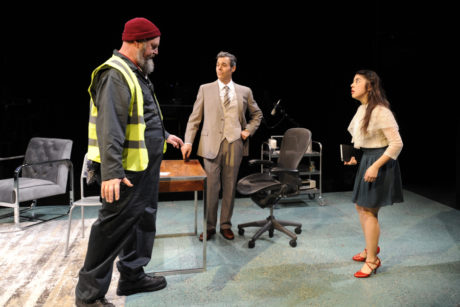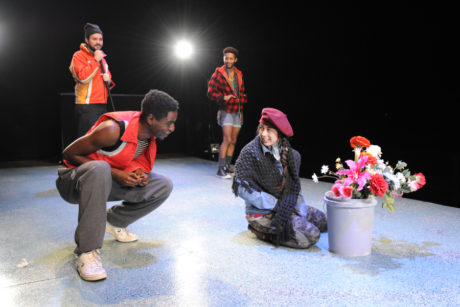Quintessence Theatre has built a strong reputation as a home for classic drama. But now they’ve dived into the American Musical Theatre canon in a big way by staging one of the most popular and cherished musicals of all time. And fittingly, it’s My Fair Lady – a show with a storied classical heritage, as the story in Lerner and Loewe’s musical has its roots in Shaw and Ovid. (Ovid’s story is even acted out silently during the overture, emphasizing the classical connection.)

Quintessence’s take on the tale of a Cockney flower seller and the linguistics professor who attempts to pass her off as a proper society lady shines, largely thanks to its excellent performances. Gregory Isaac is suitably conceited, obstinate and disdainful as Professor Henry Higgins, and his fine baritone does justice to Frederick Loewe’s melodies (which is more than you can say for some of the actors who have played this part). And Leigha Kato has a glorious soprano and an indomitable attitude as Eliza Doolittle, making her struggle appear crucial and vital.
There are also fine comic turns from Doug Hara as Colonel Pickering and from Marcia Saunders, who doubles as Higgins’ mother and as his landlady. Lee Cortopassi, as Eliza’s suitor Freddy, shows off a sterling tenor and a genial attitude on the gorgeous ballad “On the Street Where You Live.” And Bradley Mott is a hoot as Eliza’s father, bringing a booming voice and a droll sensibility to raucous comedy numbers like “Get Me to the Church on Time.” The rest of the 12-member ensemble offers sturdy support, performing Kaki Burns’ sprightly choreography.
And yet, as impressive and enjoyable as so much of this My Fair Lady is, there are some significant problems with it. First and foremost is the sound – or rather, the lack of sound. Director Alexander Burns has staged the show on a wide runway with the audience on two sides; at either end of the runway sit two piano players (Amanda Morton and Musical Director Christopher Ertelt) who accompany the singers. (This two-piano, pared-down adaptation of My Fair Lady has proved quite popular at regional theaters for a decade or so now.) And while it’s great to hear the human voice unamplified, the staging requires the actors to turn away from half the audience at crucial points to sing to the other half of the audience. The result is that nearly half of the lyrics are unintelligible, depending on where you’re sitting.
Then there’s the physical look of the show. Instead of being set in London circa 1913, we’re in what appears to be in the present day. But the sharp class divisions of Edwardian England, so central to the musical (and to Shaw’s Pygmalion), have no modern-day equivalent, so the transfer is not a smooth one – and Alan Jay Lerner’s book and lyrics are so efficient and incisive that the setting doesn’t need the story to be updated in order for it to become relevant.

As a result, Doug Greene’s set design is filled with modern metal furniture and appliances; Pickering calls the police on a cordless phone, while Higgins records and plays back Eliza’s voice lessons on a Macbook. (Lerner’s script is unchanged, so Higgins makes references to a phonograph, cylinders and a gramophone – references that, in this context, make him look stodgy and silly.) All of this is played out against the cold, black background of the curtains that surround the playing area (relieved by David Sexton’s fine lighting).
And Christina Bullard’s costume design goes overboard in its desire to look contemporary. Eliza first appears wearing a jeans jacket, army fatigue pants, and boots, while carrying her flowers in a plastic industrial bucket rather than a basket. During “Wouldn’t It Be Loverly,” the chorus members wear basketball shorts and sneakers. (Kudos to the actors, though, for being able to tap dance while wearing sneakers.) Higgins and Pickering wear handsome suits, but Eliza wears modern dresses of various styles and lengths; some look good, but most look ridiculously inappropriate. During the scene at the Ascot racecourse, Higgins’ mother observes him in his “casual” tweeds – which look rather formal by modern standards – and scoffs, “You’re not even dressed for Ascot.” Considering Eliza soon arrives wearing a strapless orange cocktail dress and plastic shoes, one wonders how Mrs. Higgins can tell.
(Incidentally, the printed program devotes two pages to an explanatory director’s note and one page to a list of the works of Shaw, Ovid, and Lerner and Loewe – yet it fails to provide a list of the songs, which I would think most theatergoers would find much more useful.)
My Fair Lady is a near-perfect musical, and even the bizarre costumes and off-kilter staging can’t keep a great show down. Anyone who loves this show will find much to enjoy here.
Running Time: Two hours and 55 minutes, including one intermission.

My Fair Lady plays through December 17, 2017 at Quintessence Theatre Group, performing at the Sedgwick Theater – 7137 Germantown Avenue (Mount Airy) in Philadelphia, PA. For tickets, call (215) 987-4450, or purchase them online.




